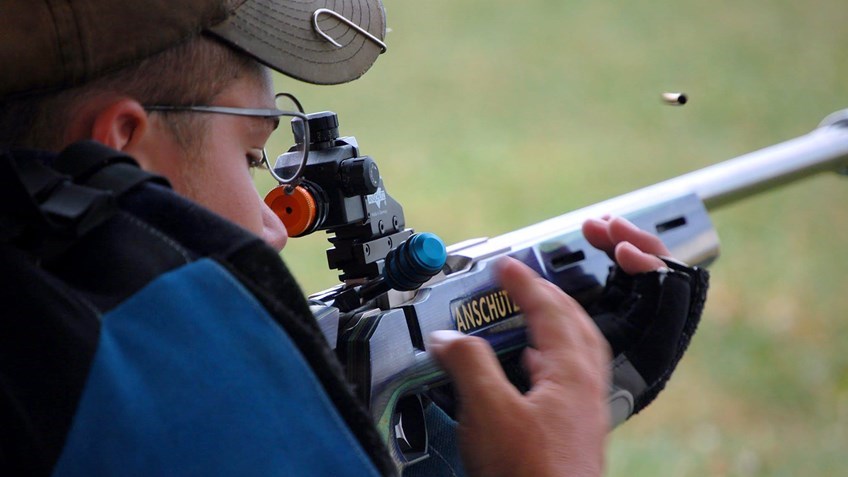Fun and simplicity are the two keys to choosing a first shooting sport experience. These are proven great beginnings! Read more…

SOURCE: Shooting Sports USA, by John Parker
These days there is no shortage of new sports for prospective shooters who believe they are ready to take the plunge into formal competition. The three disciplines listed below are ideal for beginners.
ONE: BB Gun/Air Rifle
Air guns are traditionally regarded as guns for beginners. Some types, such as the familiar BB gun, are excellent as a “first competition gun,” while there are numerous other types designed and used by seasoned international competitors. One great reason for air rifle shooting is how easy it is to set up a range, even in your own home.
Juniors can compete in BB gun until their 16th birthday. NRA rules define BB guns as: Any shoulder held smoothbore BB gun with metallic sights, in which the propelling force is developed through the use of a compressed spring, gas or compressed air. Courses of fire are 40 shots; 10 each in prone, standing, sitting and kneeling, or the three-position course of fire which omits sitting. Also something to note: NRA BB Gun rule 7.10 provides for ISSF-style “Finals” for top competitors at matches to have a chance to show off their shooting prowess. Matches with Finals also provide for a great learning experience for those who plan to continue his/her shooting career.
The NRA Sporter Air Rifle Position rules govern the conduct of 10 meter three-position and four-position air rifle shooting. The rules allow for any type of compressed air or CO2 rifle with a few restrictions: Only .177-cal. pellets are allowed, and the weight of the rifle may not exceed 7½ pounds. Prone, sitting, kneeling and standing are the four positions utilized. Common courses of fire for sporter air rifle are: 10 shots each prone, standing, sitting and kneeling; 10 shots each prone, standing and kneeling; 20 shots each prone standing, sitting and kneeling; 20 shots prone, standing and kneeling; 40 shots standing; and/or 60 shots standing. NRA Sporter Air Rifle also has rules for a “Finals” for sanctioned matches, very much like BB gun.
BB guns and air rifles are an excellent way to begin competing in the shooting sports. In recent years, air guns have undergone dramatic improvements in reliability, durability and accuracy. These guns offer flexibility?because they can be fired safely by shooters of all ages and experience levels.
TWO: Smallbore Rifle
Smallbore rifle competition is the logical next step after learning the ropes with an air gun. It’s a sport that dates back to 1919, back when companies like Savage and Winchester introduced special .22 target rifles, the Winchester Model 19 NRA Match Rifle and the popular Savage Model 52. To be a precise and accurate smallbore shooter, you’ll need a quality rifle, sights and ammunition. But you really don’t need a new rifle to try out the sport of smallbore rifle; if you have a decent .22 LR in your safe, just use that to begin.
The NRA Smallbore Rifle rules allow for just about any .22-caliber rimfire rifle for use in competition. There are no restrictions on the barrel length or the weight of the rifle.
NRA Smallbore courses of fire are shot over 50 feet, 50 meters and 100 yards. There are four positions utilized (see Section 7 of the NRA Smallbore rules): prone, sitting, kneeling and standing. All four may be used, or even just one, depending on the match. NRA smallbore can be fired indoors or outdoors.
Recently a new form of prone shooting?Metric prone?has gained in popularity. It’s a combination of the two styles of smallbore prone shooting, NRA and ISSF, using a more difficult target with a shorter course of fire.
THREE: GLOCK Shooting Sports Foundation (GSSF)
Are you more interested in action shooting, rather than shooting at static paper targets? There’s no denying the satisfying feeling one has when shooting steel and hearing that characteristic “ding.” GSSF is one of the most popular practical shooting disciplines around, and not because it’s an easy sport?it’s mostly because the main requirement is the use of a GLOCK pistol, which isn’t that hard to scrounge up if you don’t have access to one already. GSSF stages will include steel plate racks or poppers, and others will use the NRA Action Pistol D-1 tombstone target, or combinations of both steel and paper.
Think of GSSF as “practical shooting-lite.” There’s a total of eight divisions: Civilian, Guardian (law enforcement, firefighter, military etc.), Subcompact, Competition, Heavy Metal, Major Sub, Masterstock, and Unlimited. No holsters are necessary, and the common G17 model can be used for any category except for Subcompact and Major Subcompact.
GSSF shooters are divided into masters and amateurs. Masters are defined as “competitors who are classified as ‘master class’ in USPSA, PPC, ICORE, NRA, Cowboy Action, or shoot on an Armed Forces shooting team, or have been promoted to master by GSSF.” All other shooters are considered amateur.
Want to learn more about the shooting sports? Visit www.ssusa.org!








